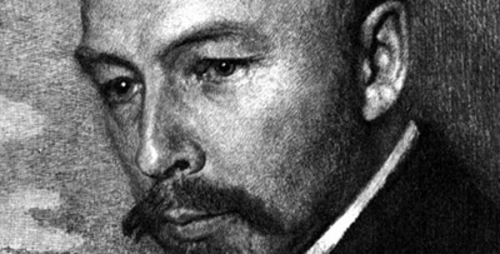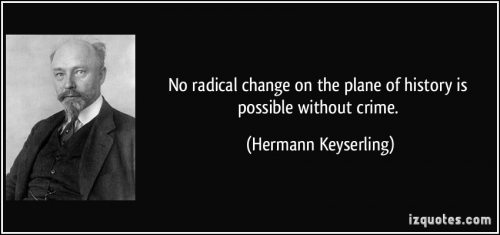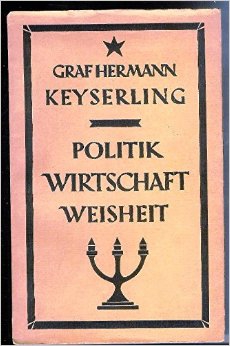samedi, 15 août 2015
Hermann Keyserling’s America

Hermann Keyserling’s America
A half-forgotten German philosopher’s profound analysis of the United States
Ex: http://www.counter-currents.com
When the German philosopher Count Hermann Keyserling, the centennial of whose birth was celebrated last year by a very small but dedicated band of followers, made a four-month lecture tour of the United States in 1928, it was his second visit to the country. The first had taken place before World War I, in the midst of a trip around the world, and was duly noted in his erudite bestseller, Travel Diary of a Philosopher. The book he produced after his second visit to the States, which he wrote in English, was America Set Free (Harper and Brothers, New York, 1929). In the introduction he was careful to point out that this “is not a book on America, but for Americans . . . the productive effect it may have depends primarily on my readers adopting the right sort of attitude from the outset.” The work, he insisted, should not be considered an exercise in criticism. “I have,” he emphasized, “tried to disentangle America’s truth from untruth . . .”
Keyserling judged the average American to be a fair psychologist who, nevertheless, often encounters difficulties in understanding ways of living that differ from his own. This difficulty arises in part from the average American’s limited contact with other nations, a circumstance which later changed after masses of Americans in their numerous twentieth-century wars had the opportunity to come into personal contact with many foreign peoples. From this viewpoint war is not exclusively negative. It often helps to build bridges to foreign nations, some of them long-time enemies.
Emigrants, Keyserling believed, often preserve their original race character. Accordingly, an American with a distinctly American physique and a distinctively American soul could not appear overnight. How could an American soul take shape when no gods, except Manitou, had been born on U.S. soil? The birth of a national mentality derives from a range of emotions linked to the earth and not to the asphalt of the city. The variety of immigrants who came to America with their varied religious denominations from several parts of Europe turned the United States into a sort of New World Balkans. But this variety could have a positive effect. In the same way that what is good for Europe often depends on its multiplicity, the American melting process contains a large number of “vital roots of creativeness.” The narrowness of isolated countries cut off from the world can lead to degeneration.
Being an admirer of Houston Stewart Chamberlain, Keyserling was very much aware of the importance of heredity and eugenics and, as he calls them, the laws of blood. “The Jew,” he asserted, “cannot easily become part of a new nation. Since he is essentially ‘spirit-born’ and has no support from the forces of the earth, his process of denationalization only too often leads to moral putrefaction. . . . The ability to preserve the original character of a race after it emigrates to a foreign land seems to be an occupational specialty of the Jews. They have had no really native country for thousands of years; they have spread all over the earth, settling down in almost all countries; having become a fundamentally parasitic nation . . . they have lived in closer touch with ‘environment’ than most autochthonous races. And yet they have always remained, even as a physical type, what they were originally. This is due to two causes. Firstly, to the unequalled understanding the Jews possess of the laws of the blood. Second, to the Jewish mentality. For the Jew the law of his religion is always his real ‘environment.’ Since he had to practice Judaism with the utmost strictness, consistency and severity, his life was psychologically determined. Owing to this, he has proved stronger than nature. He has maintained his original type in spite of the varying influences brought to bear on him. On the other hand, if the Jew ever becomes unfaithful to his law, the result is truly disastrous. Such a disaster has been avoided only where he has immediately succeeded in becoming part of a new national body, as in Spain and to a certain extent in Italy” (pp. 26–27).
The psychological determination Keyserling has attributed to the Jewish people, however, he also ascribes to the Anglo-Saxon Puritan. Puritanism represents a typical reincarnation of the spirit of the Old Testament, by which a link had been established between Jewish and Puritan traits. Also, in the case of the typical Puritan, his spiritual force resisted the influence of the American environment and helped to preserve the original ancestral type. Gradually, as the Puritan and the American pioneer merged into one, Puritanism became the very essence of American politics, of American military tradition and of American business, the latter embodying a synthesis of religion, work and enterprise. The New England culture founded by the Puritan fathers, however, was from the very beginning extremely narrow in comparison to the aristocratic tradition of Virginia. But time, Keyserling stated, still works for the American of the Virginian type, a superior stock which is represented by the “cavalier” and which will gradually assure the future predominance of the American South. Meanwhile, the moralistic New Englander will become obsolete, while the Middle Westerner will be considered the true reflection of the American spirit and both the real and symbolic cornerstone of the American nation.
Keyserling saw the average American as a child of unlimited horizons. The sense of continental vastness seems to lead to the American goal of the “spiritual Americanization of the world,” since the American “is always a missionary, no matter whether as a preacher, a salesman, or a headlining newspaper writer” (pp. 9–10). It was this missionary spirit which caused Americans to try to make the world safe for democracy and thereby open the door to an “American century.”
But America, Keyserling pointed out fifty years ago, faced a number of great dangers as “the majority of the population constitutes what under the Indian system would have formed the lower castes. The spirit of the conquering race still rules, but the race has changed” (p. 33). The Puritan spirit began to vanish in the North in the same way as the spirit of the Nordic invaders of old India gradually disappeared.

As with many foreign investigators of the American scene, Keyserling was alarmed by the Negro problem. “For if the white American continues on his present line of development then America may end up by becoming the Black Continent of post-modern times. We know today that from palaeolithic days onward there have been at least three great civilizations in Africa, the original representatives of which were not black. . . . But the ruling races eventually lost their vitality; they lived too much aloof from Mother Earth. So the Negro, although inferior, had the last word.” Keyserling went on, “I do, of course, not really believe that America will end as the Black Continent of the future, but I thought it wise to over-stress at this point the dangers of urban civilization, because as yet Americans do not seem to be at all aware of them” (pp. 41–42).
The author compared America to Rome and Greece, which he characterized as heroic and individualistic, but which gradually dissolved into the populations of the original settlers, as the laws were made “by a race not belonging to the ruler-type” (p. 71). Similarly in America, the vital pioneer impulses gradually weakened.
An overmechanized, overstandardized economy can easily lead to an end of the technical era and a collapse of man himself. When Keyserling wrote America Set Free, the North was undergoing a growing industrial restlessness and expansion, while the South seemed to be half asleep. Today the South, once characterized by an aristocratic type of life, is running the risk of being dominated by a materialism which both directs and represses the cultural evolution of its inhabitants. The American South had hitherto been more influenced than the North by the forces of the soil. Matter and intellect, according to Keyserling, belong together in the same way as the soil and the soul. Only by joining the worlds of the intellect and emotions, mind and feeling, is modern man able to help us solve the problems of a world which is now being formed more by matter than by man himself, who has become a prisoner of matter. Logic, mathematics and reason are found on the side of dead matter while life itself is symbolized by the emotional world. Reason, intellect and law, as represented by ancient Rome, are the antithesis to the Greek world of beauty. Above all, it is the soul that creates man and fixes his character, not mind and reason. Today the world of matter rules not only in Communist states, but also in the Western world. That is why Keyserling emphasized the importance of a synthesis of the intellect and soul and values so highly a culture of being as opposed to a culture of merely knowing, having and doing (“eine Kultur des Seins anstatt einer Kultur des Könnens”).
A wholly mechanized world must sooner or later lead to a fiasco for mankind. “If man is rightly adjusted within the cosmic scheme as an animal only, he is actually not rightly adjusted. He does not live out of, nor up to the intrinsic meaning of his life; and since what I call ‘meaning’ stands for its very wellspring, not unlimited progress, but devitalization and, eventually, the end of the civilized race would be the inevitable outcome if the process were to continue much longer. This is the all-important point. . . . It is not a question of human nature in the all-embracing sense of the word. A civilization without spiritual roots consciously realized as real is not only incomplete—it is actually without roots. It resembles at best the blossom in a vase. The great task, then, of the centuries to come is to develop a new spiritual life on the foundations of the Technical Age” (pp. 585–86).
Hand in hand with technology, Keyserling saw a worldwide conformity taking place. Man becomes more and more a collective being adapted to mechanical devices and is beginning to resemble a cog in a machine. And there is no great difference between the collective man in the United States and in the Soviet Union. “The difference between the facts of Bolshevik Russia and America . . . only amounts to a difference in prosperity; the standard is different, but the standardization is identical. . . . America expresses its socialism in the form of general prosperity, and Russia in the form of general poverty. America is socialistic by means of the free cooperation of all, and Russia by means of a class rule” (pp. 253–54).
 Keyserling was very pessimistic about America’s influence abroad. He believed President Wilson’s Fourteen Points “have really wrecked Europe and imperilled the position of the whole white race. They are the spiritual parents of Bolshevism because, but for the idea of the self-determination of nations and Wilson’s utter disregard of historical connexions, the Bolsheviks would never have succeeded in revolutionizing the whole East and never even dreamt of attempting the same in Europe” (p. 84).
Keyserling was very pessimistic about America’s influence abroad. He believed President Wilson’s Fourteen Points “have really wrecked Europe and imperilled the position of the whole white race. They are the spiritual parents of Bolshevism because, but for the idea of the self-determination of nations and Wilson’s utter disregard of historical connexions, the Bolsheviks would never have succeeded in revolutionizing the whole East and never even dreamt of attempting the same in Europe” (p. 84).
In World War I the Allies liquidated the psychological foundations of the old social order. In the United States a new type of man emerged—a more violent man, full of vitality and empty of culture. At the same time the ancient ideal of man was born or reborn. With Charles Lindbergh, “a modern Siegfried,” another Americanism took shape, a new consciousness of the American soul. Keyserling characterized this new America as “a decidedly intelligent nation” and the new Americans as “good psychologists, no thinkers, intelligent, but not intellectual.”
“Spirit,” Keyserling had already written in the Travel Diary of a Philosopher, “can manifest itself on earth only by means of material tensions, precisely as tightened strings only can produce musical sounds.” Comfort can never create true culture, which only develops where beauty is the highest value. The spirit of competition helps to create a part of the tension that makes men aspire to something higher. Uniformity, however, cannot create any culture. Only an innate emphasis on privacy, Keyserling called it privatism, may help reveal to Babbitts what a true American civilization can and should be.
Biographical Note
Hermann Keyserling was born in July 1880, at Könno, Estonia, then as today a Russian province. Having attended the universities of Geneva, Dorpat, Heidelberg and Vienna, he acquired a Ph.D. in geology in 1902. Before leaving for an extended visit to France, he worked on his father’s estate in Estonia, where he did some original research in farming methods. During his Paris years he published his first book, Das Gefüge der Welt (1906), in German and his second in French, Essai critique sur le système du monde (1907). The same year he became a professor of philosophy at the University of Hamburg. His lectures there were subsequently published under the title, Prolegomena zur Naturphilosophie (1910). In 1911–12 came his trip around the world and Travel Diary of a Philosopher (Reisetagebuch eines Philosophen). The New York Times compared it to Dante’s Divine Comedy, while the London Times called its author “a Buddha among philosophers.” Hermann Hesse, later a Nobel laureate, wrote, “this book of a European thinker of our time . . . is going to exercise the strongest influence on this epoch.”
In 1919 Keyserling married Countess Godela Bismarck, the granddaughter of Otto von Bismarck, who bore him two sons, Manfred and Arnold, both of whom became philosophers and psychologists. The latter is a professor in Vienna and the author of fifteen books.
After the confiscation of his estates by the government of Estonia, Keyserling was invited by Grand Duke Ernst Ludwig to move to Darmstadt, Germany, where in 1920 he founded his School of Wisdom. Internationally known scholars lectured there, among them Rabindranath Tagore, Carl Jung and Leo Frobenius. At the school he wrote several of his later works, which are too numerous to mention here. After the destruction of his house and library at Darmstadt by Allied bombers in World War II, Keyserling left Germany for Austria. He died at Innsbruck in the spring of 1946. “He is not,” French critic Pierre Frédéric said in 1946 at Keyserling’s death, “like Bergson, Leibnitz or Berkeley, the creator of a derivative philosophical system; he is instead a searcher after the great spiritual currents which traverse and reform our planet—a Pythagoras or Socrates at the threshold of the twentieth century.”
The great bulk of Keyserling’s correspondence has not yet been published. Among his epistolary friends were Bernard Shaw, Houston Stewart Chamberlain, Claude Debussy, Auguste Rodin, André Gide, Albert Schweitzer, Bertrand Russell, Oswald Spengler, Sigmund Freud, Miguel de Unamuno and José Ortega y Gasset.
Hermann Keyserling propounded a synthesis of the deepest wisdom of the Occident and Orient. His universality reached from philosophy, religion, psychology and history to biology, geology, economics, astronomy and the world of music. It was his lifetime desire to help man find a fundamental reason for existence. Frank Thiess, a modern European writer, said about Keyserling, “He became what Nietzsche always had aspired to be.”
What mankind needs, Keyserling repeatedly stressed, is to forge an unbreakable link from the intellect to the soul. The predominance of one or the other has always led to chaos and disaster. We must come to revere something higher than mere materialistic aspirations and moral values. In a generation which revels in materialism, egoism and the ugliest elements of modernism, it is our duty to emphasize the distinctly superior sentiments that flow from an aristocratic mind.
Hermann Keyserling said that his family, which many centuries ago had gone to the Baltic States from Germany as knights and governors, were veritable giants in height. They were also giants of the spirit. One Keyserling was the friend and benefactor of Johann Sebastian Bach. Another was the closest friend of Immanuel Kant; another the chief adviser of Frederick the Great. Count Alexander Keyserling, Hermann’s grandfather, was a leading member of the Baltic nobility and, as a geologist, helped discover much of the mineral wealth of Czarist Russia. Bismarck was referring to this Keyserling when he said he was the only human being whose mind he feared.
Arnold Keyserling wrote about his father:
In order to understand man, he had to start from the unity of the globe, and to transcend the barriers between East and West, as well as between the different religions. The School of Wisdom he created was meant to shape the ideal of the ecumenical man, whose time was to come after the period of the great wars. It was his opinion that only through delving into both origins, the terrestrial as well as the spiritual, could man finally attain integration and self-realization.
Author: Swedish Instaurationist
Source: Instauration, January 1981, pp. 9–11.
00:05 Publié dans Philosophie, Révolution conservatrice | Lien permanent | Commentaires (2) | Tags : philisophie, hermann keyserling, révolution conservatrice, allemagne, états-unis, américanisation |  |
|  del.icio.us |
del.icio.us |  |
|  Digg |
Digg | ![]() Facebook
Facebook


